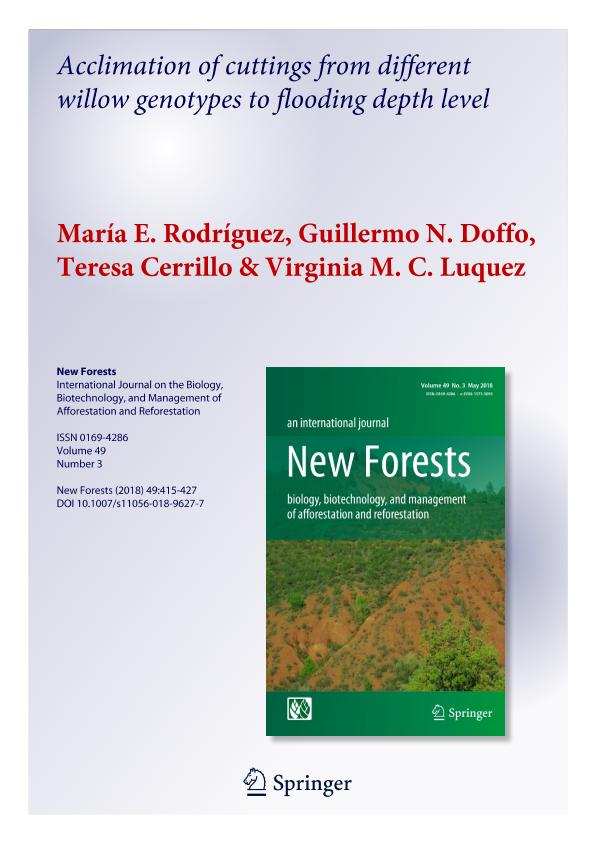Mostrar el registro sencillo del ítem
dc.contributor.author
Rodríguez, María Emilia

dc.contributor.author
Doffo, Guillermo Nestor

dc.contributor.author
Cerrillo, Teresa

dc.contributor.author
Luquez, Virginia Martha Cristina

dc.date.available
2020-01-06T20:25:54Z
dc.date.issued
2018-05
dc.identifier.citation
Rodríguez, María Emilia; Doffo, Guillermo Nestor; Cerrillo, Teresa; Luquez, Virginia Martha Cristina; Acclimation of cuttings from different willow genotypes to flooding depth level; Springer; New Forests; 49; 3; 5-2018; 415-427
dc.identifier.issn
0169-4286
dc.identifier.uri
http://hdl.handle.net/11336/93707
dc.description.abstract
Climate change will increase the frequency of extreme rain events, causing more flooding episodes. Willows are usually planted in marginal lands like flood prone areas. For willow plantations developed from rootless cuttings, the establishment phase is crucial, because the cuttings are still developing a shoot and root system and have a higher vulnerability to stress. A flooding episode during this early period may have a negative effect upon plants. We analyzed the responses to flooding of eight willow genotypes, representing important species from the economic and ecological point of view (Salix alba, S. matsudana, S. amygdaloides and S. matsudana × S. nigra hybrids). The treatments started when the plants were 2 months old and lasted for 3 weeks. They were identified as: Control (watered to field capacity); F10 (plants submerged 10 cm above soil surface) and F50 (plants submerged 50 cm above soil surface). The F50 treatment showed a greater growth reduction than the F10 treatment in most clones, either measured in height, diameter or total biomass. Both flooding treatments reduced significantly the root-to-shoot ratio compared to control plants. The F50 treatment increased the leaf nitrogen content and specific leaf area in all genotypes. Both treatments changed plant and leaf traits in different ways according to the depth of the floodwater. These changes may have lasting effects on growth recovery in the post-flooding period. Willow clones with a fast initial growth will be the best option to minimize growth reduction in areas prone to experience flooding episodes.
dc.format
application/pdf
dc.language.iso
eng
dc.publisher
Springer

dc.rights
info:eu-repo/semantics/openAccess
dc.rights
Atribución-NoComercial-CompartirIgual 2.5 Argentina (CC BY-NC-SA 2.5 AR)
dc.rights.uri
https://creativecommons.org/licenses/by-nc-sa/2.5/ar/
dc.subject
FLOODING
dc.subject
NITROGEN
dc.subject
ROOT-TO-SHOOT RATIO
dc.subject
SALIX SPP
dc.subject
SPECIFIC LEAF AREA
dc.subject.classification
Otras Agricultura, Silvicultura y Pesca

dc.subject.classification
Agricultura, Silvicultura y Pesca

dc.subject.classification
CIENCIAS AGRÍCOLAS

dc.title
Acclimation of cuttings from different willow genotypes to flooding depth level
dc.type
info:eu-repo/semantics/article
dc.type
info:ar-repo/semantics/artículo
dc.type
info:eu-repo/semantics/publishedVersion
dc.date.updated
2019-10-18T18:33:11Z
dc.journal.volume
49
dc.journal.number
3
dc.journal.pagination
415-427
dc.journal.pais
Alemania

dc.journal.ciudad
Berlín
dc.description.fil
Fil: Rodríguez, María Emilia. Consejo Nacional de Investigaciones Científicas y Técnicas. Centro Científico Tecnológico Conicet - La Plata. Instituto de Fisiología Vegetal. Universidad Nacional de La Plata. Facultad de Ciencias Naturales y Museo. Instituto de Fisiología Vegetal; Argentina
dc.description.fil
Fil: Doffo Guillermo. Consejo Nacional de Investigaciones Científicas y Técnicas. Centro Científico Tecnológico Conicet - La Plata. Instituto de Fisiología Vegetal. Universidad Nacional de La Plata. Facultad de Ciencias Naturales y Museo. Instituto de Fisiología Vegetal; Argentina
dc.description.fil
Fil: Cerrillo Teresa. Instituto Nacional de Tecnología Agropecuaria. Centro Regional Buenos Aires Norte. Estación Experimental Agropecuaria Delta del Paraná; Argentina
dc.description.fil
Fil: Luquez, Virginia Martha Cristina. Consejo Nacional de Investigaciones Científicas y Técnicas. Centro Científico Tecnológico Conicet - La Plata. Instituto de Fisiología Vegetal. Universidad Nacional de La Plata. Facultad de Ciencias Naturales y Museo. Instituto de Fisiología Vegetal; Argentina
dc.journal.title
New Forests

dc.relation.alternativeid
info:eu-repo/semantics/altIdentifier/url/https://link.springer.com/article/10.1007%2Fs11056-018-9627-7
dc.relation.alternativeid
info:eu-repo/semantics/altIdentifier/doi/https://doi.org/10.1007/s11056-018-9627-7
Archivos asociados
